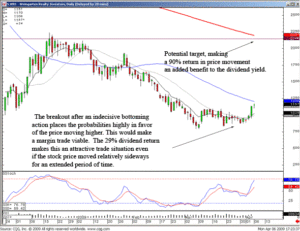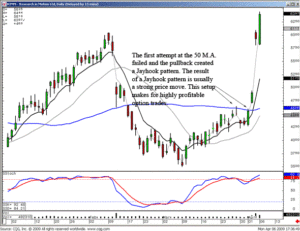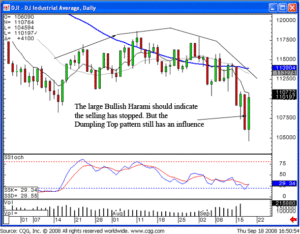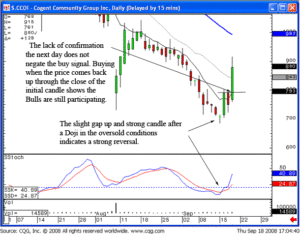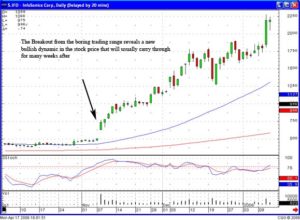DISCLAIMER
Candlestickforum.com and Candlestick-Trading-Forum.com (Candlestick Forum LLC) are designed to help readers obtain trading education and discuss ways to trade the markets using Japanese Candlestick analysis in the decision process. There are no warranties implied.
The fundamental concept is that you should NOT rely solely upon the information or opinions you read. Rather, you should use what you read as a starting point for doing independent research on Japanese Candlestick analysis and trading methods. Then judge for yourself the merits of the material that has been shared in the Candlestickforum.com and Candlestick-Trading-Forum.com websites and supporting materials.
Candlestickforum.com, Candlestick-Trading-Forum.com and Candlestick Forum LLC do not recommend or endorse any specific trading system or method. We recommend that you research all trading systems, methods and market strategies thoroughly.
You should carefully consider whether trading the markets is appropriate for you in light of your experience, objectives, financial resources and other circumstances.
These web sites and their information are provided for guidance and information purposes only. These web sites, their content and their products offered are not intended to provide investment, tax, or legal advice.
The information contained herein has been compiled from sources deemed reliable and it is accurate to the best of our knowledge and belief; however, Candlestickforum.com and Candlestick-Trading-Forum.com (Candlestick Forum LLC) cannot guarantee as to its accuracy, completeness and validity and cannot be held liable for any errors or omissions. Changes are periodically made to these web sites and may be made at any time.
All information contained herein should be independently verified and confirmed. All discussions regarding specific market trades are for illustration purposes only and do not constitute buy/sell recommendations.
Candlestickforum.com and Candlestick-Trading-Forum.com (Candlestick Forum LLC) do not accept any liability for any loss or damage whatsoever caused in reliance upon such information.
Candlestick Forum LLC, all owners, and all employees are not registered broker/advisors or Investment Advisors. Any and all communication, either written or verbal, are made in good faith but should not be considered as specific buy/sell recommendations. All detailed discussions, written or verbal, are for illustration purposes only.
Reader agrees to indemnify and hold harmless Candlestickforum.com and Candlestick-Trading-Forum.com (Candlestick Forum LLC) from and against any damages, costs and expenses, including any legal fees, potentially resulting from the application of any of the information provided by Candlestickforum.com and Candlestick-Trading-Forum.com (Candlestick Forum LLC). This disclaimer applies to any damages or injury caused by any failure of performance, error, omission, interruption, deletion, defect, delay in operation or transmission, computer virus, communication line failure, theft or destruction or unauthorized access to, or use of record, whether for breach of contract, tort, negligence, or under any other cause of action.
Candlestickforum.com and Candlestick-Trading-Forum.com (Candlestick Forum LLC) make no guarantee that you will make money with trading any market.
Reader agrees to assume all risk resulting from the application of any of the information provided by Candlestickforum.com and Candlestick-Trading-Forum.com (Candlestick Forum LLC).
By using these web sites, including any applets, software and content contained therein, the visitor agrees that the use of these web sites and their information products is entirely at his/her own risk.
All mentions of specific stocks, market observations, general comments, written materials, or audio dicussions in internet web rooms are intended to provide educational content only and NO Recommendations for trading are implied from these sources.
The Member Trading Chat Room is open to paying members only. Any and all comments made in this room are NOT monitored or endorsed by Candlestick Forum, LLC. All efforts are made to ensure any offensive or abusive behavior is not tolerated. However, this is ‘live’ and not under our control. Report any abusive activitiy to the webmaster@candlestickforum.com.
REFUND POLICY
Should a customer have a concern or is displeased with their order, the Candlestick Forum LLC will make every effort to rectify that concern or displeasure as soon as possible. This includes offering replacements and refunds. Candlestick Forum LLC wants our Candlestick investors to be happy with all of our products and has a 100% money back guarantee policy. Contact the Candlestick Forum within 30 days of your purchase to obtain a replacement or refund on your order.
Membership enrollment is not refundable. Within the first 30 days, should you decide the Candlestick Trading Forum is not for you simply cancel, by updating your member profile and selecting cancel, or contact us to discontinue automatic renewal. You still keep all of your new membership products (valued at $290) for your own personal use!
Our 100% guarantee is honored on all orders under $250. All requests must originate from the payee or credit card holder within 30 days of purchase and must be submitted by e-mail or in writing.
Qualified customers have the option of requesting a replacement order or a full refund. Understandably, should a customer request a replacement order they will not be eligible for a full refund on their replacement order.
The Candlestick Forum LLC refund policy is only applicable to customers that purchased services at regular prices. Any special offers or those obtained from our third-party relationships that involved discounts on products or services cannot be refunded but are eligible for replacement.
MEMBERSHIP TERMS OF SERVICE
Member understands that The Candlestick Forum LLC is not a registered Investment Advisor or a Broker/Dealer. Members are advised that all information is for educational purposes only and is not to be construed as an offer to sell or the solicitation of an offer to buy. The opinions and analyses included are based on sources believed to be reliable and written in good faith, but no representation or warranty, expressed or implied, is made as to their accuracy, completeness or correction. Members are urged to consult with their own independent financial advisors with respect to any investment information contained on this site and should be independently verified with the companies mentioned. The Candlestick Forum LLC owners or staff may or may not have positions in the stocks mentioned. In addition, The Candlestick Forum LLC is taking no compensation of any kind from any companies mentioned. Password sharing is prohibited and strictly enforced. Any abuse will constitute immediate termination of membership and all monies forfeited.
Membership enrollment is not refundable. Within the first 30 days, should you decide the Candlestick Trading Forum is not for you simply cancel, by updating your member profile and selecting cancel, or contact us to discontinue automatic renewal. You still keep all of your new membership products for your own personal use! Membership renewal is automatically renewed on the last day of your enrollment period. You may cancel automatic renewal by updating your member profitle and selecting cancel. You will have continued access to the member area until the end of your currently paid enrollment period.
In summary I agree to the following terms before selecting to purchase a paid membership;
With your subscription, you agree to the following terms:
- I understand that The Candlestick Forum LLC is not responsible for any technical failures that may occur. I will notify The Candlestick Forum LLC of any change in my email address.
- I understand investing involves substantial risk, may result in serious financial loss, and is not suitable to everyone. I understand I am responsible for my own investment decisions.
- I understand The Candlestick Forum LLC, all guest speakers, and all Candlestick Forum Team members may provide useful tools for making investment decisions, but is not a substitute for my own personal judgement. Any trading decision I make is my sole responsibility.
- I understand my membership fees renew automatically unless I select ‘cancel’ in my member profile, or provide other written request.
RETURN TO ORDER MEMBERSHIP
USE OF CONTENT
You may view, download, and print contents from this site subject to the following conditions:
1) content used solely for your personal use; you may not forward subscription information to others;
2) content must bear proper attribution to The Candlestick Forum LLC with link to www.candlestickforum.com website;
3) content may not be modified in any way.
You may not republish, distribute, or otherwise use the content other than as explicitly permitted.
You may not frame or utilize framing techniques to enclose any trademark, logo, or other proprietary information (including images, text, page layout, or form) of Candlestick Forum LLC. without the express written consent.
Copyright Information
All content included on this site, such as text, graphics, logos, button icons, images, audio clips, digital downloads, data compilations, archived recordings, is the property of Candlestick Forum LLC and protected by United States and international copyright laws.
PRIVACY POLICY
Candlestickforum.com and Candlestick-Trading-Forum.com (Candlestick Forum LLC) strive to offer its visitors the many advantages of Internet technology and to provide an interactive and personalized experience. We may use Personally Identifiable Information (your name, e-mail address, street address, telephone number) subject to the terms of this privacy policy. We will never sell, barter, or rent your email address to any unauthorized third party. Period.
How we gather information from users
How we collect and store information depends on the page you are visiting, the activities in which you elect to participate and the services provided. For example, you may be asked to provide information when you register for access to certain portions of our site or request certain features, such as newsletters or when you make a purchase. You may provide information when you participate in sweepstakes and contests, message boards and chat rooms, and other interactive areas of our site. Like most web sites, Candlestickforum.com and Candlestick-Trading-Forum.com (Candlestick Forum LLC) also collects information automatically and through the use of electronic tools that may be transparent to our visitors. For example, we may log the name of your Internet Service Provider or use cookie technology to recognize you and hold information from your visit. Among other things, the cookie may store your user name and password, sparing you from having to re-enter that information each time you visit, or may control the number of times you encounter a particular advertisement while visiting our site. As we adopt additional technology, we may also gather information through other means. In certain cases, you can choose not to provide us with information, for example by setting your browser to refuse to accept cookies, but if you do you may be unable to access certain portions of the site or may be asked to re-enter your user name and password, and we may not be able to customize the site’s features according to your preferences.
Candlestickforum.com and Candlestick-Trading-Forum.com (Candlestick Forum LLC) do not recommend or endorse any specific trading system or method. We recommend that you research all trading systems, methods and strategies thoroughly.
What we do with the information we collect
Like other web publishers, we collect information to enhance your visit and deliver more individualized content and advertising. We respect your privacy and do not share your information with anyone.
Aggregated Information (information that does not personally identify you) may be used in many ways. For example, we may combine information about your usage patterns with similar information obtained from other users to help enhance our site and services (e.g., to learn which pages are visited most or what features are most attractive). Aggregated Information may occasionally be shared with our advertisers and business partners. Again, this information does not include any Personally Identifiable Information about you or allow anyone to identify you individually.
We may use Personally Identifiable Information collected on our site to communicate with you about your registration and customization preferences; our Terms of Use and privacy policy; services and products offered by us and other topics we think you might find of interest.
Personally Identifiable Information collected by Candlestickforum.com and Candlestick-Trading-Forum.com (Candlestick Forum LLC) may also be used for other purposes, including but not limited to site administration, troubleshooting, processing of e-commerce transactions, administration of sweepstakes and contests, and other communications with you. Certain third parties who provide technical support for the operation of our site (our web hosting service for example) may access such information. We will use your information only as permitted by law. In addition, from time to time as we continue to develop our business, we may sell, buy, merge or partner with other companies or businesses. In such transactions, user information may be among the transferred assets. We may also disclose your information in response to a court order, at other times when we believe we are reasonably required to do so by law, in connection with the collection of amounts you may owe to us, and/or to law enforcement authorities whenever we deem it appropriate or necessary. Please note we may not provide you with notice prior to disclosure in such cases.
Affiliated sites, linked sites and advertisements
Candlestickforum.com and Candlestick-Trading-Forum.com (Candlestick Forum LLC) expect its partners, advertisers and affiliates to respect the privacy of our users. Be aware, however, that third parties, including our partners, advertisers, affiliates and other content providers accessible through our site, may have their own privacy and data collection policies and practices. For example, during your visit to our site you may link to, or view as part of a frame on Candlestickforum.com or Candlestick-Trading-Forum.com page, certain content that is actually created or hosted by a third party. Also, through Candlestickforum.com and Candlestick-Trading-Forum.com (Candlestick Forum LLC) you may be introduced to, or be able to access, information, web sites, features, contests or sweepstakes offered by other parties. Candlestickforum.com and Candlestick-Trading-Forum.com (Candlestick Forum LLC) are not responsible for the actions or policies of such third parties. You should check the applicable privacy policies of those third parties when providing information on a feature or page operated by a third party.
While on our site, our advertisers, promotional partners or other third parties may use cookies or other technology to attempt to identify some of your preferences or retrieve information about you. For example, some of our advertising is served by third parties and may include cookies that enable the advertiser to determine whether you have seen a particular advertisement before. Other features available on our site may offer services operated by third parties and may use cookies or other technology to gather information. Candlestickforum.com and Candlestick-Trading-Forum.com (Candlestick Forum LLC) do not control the use of this technology by third parties or the resulting information, and is not responsible for any actions or policies of such third parties.
You should also be aware that if you voluntarily disclose Personally Identifiable Information on message boards or in chat areas, that information can be viewed publicly and can be collected and used by third parties without our knowledge and may result in unsolicited messages from other individuals or third parties. Such activities are beyond the control of Candlestickforum.com and Candlestick-Trading-Forum.com (Candlestick Forum LLC) and this policy.
Children
Candlestickforum.com and Candlestick-Trading-Forum.com (Candlestick Forum LLC) do not knowingly collect or solicit Personally Identifiable Information from or about children under 13 except as permitted by law. If we discover we have received any information from a child under 13 in violation of this policy, we will delete that information immediately. If you believe Candlestickforum.com or Candlestick-Trading-Forum.com (Candlestick Forum LLC) has any information from or about anyone under 13, please contact us at the address listed below.
Contacting Us – You may reach us through our Contact Page
Changes to this Policy
Candlestickforum.com and Candlestick-Trading-Forum.com (Candlestick Forum LLC) reserve the right to change this policy at any time. Please check this page periodically for changes. Your continued use of our site(s) following the posting of changes to these terms will mean you accept those changes. Information collected prior to the time any change is posted will be used according to the rules and laws that applied at the time the information was collected.
Governing Law
This policy and the use of these sites are governed by Texas law. If a dispute arises under this Policy we agree to first try to resolve it with the help of a mutually agreed-upon mediator in the following location: Houston. Any costs and fees other than attorney fees associated with the mediation will be shared equally by each of us.
If it proves impossible to arrive at a mutually satisfactory solution through mediation, we agree to submit the dispute to binding arbitration at the following location: Houston, under the rules of the American Arbitration Association. Judgment upon the award rendered by the arbitration may be entered in any court with jurisdiction to do so.
Candlestickforum.com and Candlestick-Trading-Forum.com are controlled, operated and administered entirely within Candlestick Forum LLC. This statement and the policies outlined herein are not intended to and do not create any contractual or other legal rights in or on behalf of any party.
